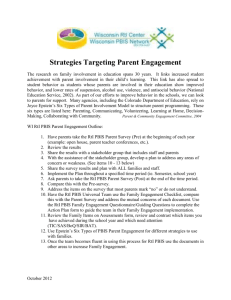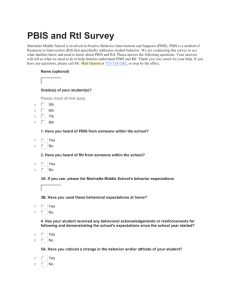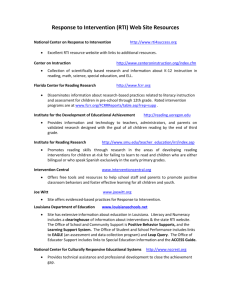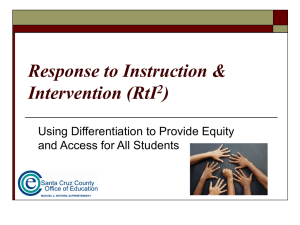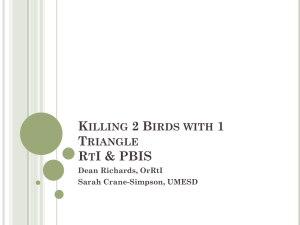DHS School Improvement Plan
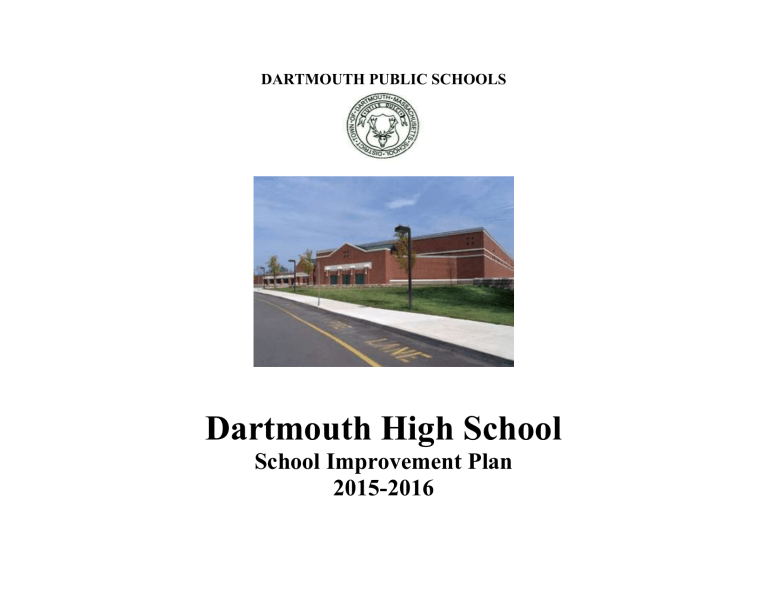
DARTMOUTH PUBLIC SCHOOLS
Dartmouth High School
School Improvement Plan
2015-2016
School Profile
Leadership:
Administrative Staff:
Dr. John Gould: Principal
Ms. Rachel Chavier: Associate Principal
Mr. Christopher L. Boyle: Dean of Students
Mr. Michael P. Martin: Dean of Students
Dean of Students: TBD
School Teams:
Leadership Team
School Council
PBIS Team
Staff Profile:
(2014-2015)
Faculty: 107
Administration: 5
Office Staff: 6
Counseling/Nurse: 7.5
Paraprofessionals: 12
Average Class Size: 17.27
Student Demographics:
(Source – June 2015 SIMS Data)
Enrollment: 1049
Male: 505
Female: 544
Black/African-American: 20
Asian:4
Hispanic: 16
White: 954
Multi-race: 51
School Improvement Plan 2015-2016 2
Leadership Team Members:
Dr. John Gould
Ms. Rachel Chavier
Mr. Christopher Boyle
Mr. Michael Martin
PBIS Team Members:
Kristin Fortin
Sheri Houle
Jodi Newbury
Monique Poyant
Eve Sky
Halley Zanconato
School Improvement Plan 2015-2016
School Council Members:
Chris Fletcher - Parent
Mark Gaffney - Physical Education Teacher
Kate Gillis - Parent
William Hakeem – Special Education Teacher
Thomas Hartman - Student
Mickenzie Kamm - Student
Joshua Moulding – Unified Arts Teacher
Jacob Oliveira - Student
Jessica Pacheco – English Teacher
Michelle Sparks - Parent
3
District Mission:
The mission of the Dartmouth Public Schools is to provide a quality education for all learners.
District Vision:
The Dartmouth Public School District, in partnership with parents and the community, will deliver challenging, standards-based instruction for all students that fosters academic, physical, social and emotional development. Utilizing data analysis to drive instruction, we will implement specific strategies to support every student to think critically, solve problems and become a responsible, contributing citizen. Our high school graduates will possess the required skills and knowledge necessary to thrive in their academic and vocational ambitions.
District Core Values and Beliefs:
Exhibit ‘Dartmouth Pride’ in all we do by:
Demonstrating personal and social responsibility through respecting others, our surroundings, and ourselves.
Developing a work ethic of perseverance, tenacity, and resiliency that encourages academic excellence to meet or exceed high standards of performance.
Discovering and broadening our individual talents.
Embracing the knowledge society with current instructional methods and tools.
Engaging in open communication with each other and our community to support student academic achievement and social and emotional growth.
District Theory of Action:
If we instruct each student with clear learning targets, assess achievement, and adjust instruction according to need; if we are continually collaborative, reflective, and purposeful; and if we engage families and the community in student learning, then student achievement will improve.
Core Areas of Focus:
Instructional Core Cultural Core Resource Core
School Improvement Plan 2015-2016 4
2014-2015 SUMMARY:
Key Strategies, Improvement Objectives, and Action Plans
INSTRUCTIONAL CORE
Key Strategy 1: Narrow the proficiency gaps between “All students” and “High Needs Students” as identified by the MCAS growth data.
Action Steps
Revise curriculum maps.
Create RTI protocol
Train faculty in RTI
Train teachers in UbD
Outcome/ Evidence
Some Curriculum Maps completed and posted on Aspen department websites.
Protocol documents created.
Faculty trained in the RTI process; participation of faculty members in RTI meetings and interventions. Student performance data pre and post RTI.
Meetings were chaired by the DHS school psychologist.
Lead teachers who volunteered and the DHS literacy coach were trained in UbD; some unit work produced in 2014-2015.
School Improvement Plan 2015-2016 5
2014-2015 SUMMARY: Key Strategies, Improvement Objectives, and Action Plans
CULTURE CORE
Key Strategy #1: Develop school wide systems of professional collaboration wherein teachers are empowered to build effective teams, collaborate within and across content areas, and grow in their profession.
Action Steps
Initiate the peer recognition “Fish” program
Outcome/ Evidence
Teachers received monthly recognition.
Provide PLC time in the professional development plan for teachers to reflect on practice, examine student work, and adjust instruction.
Provide substitute coverage for PLCs to meet during the school day to carry out curriculum, instruction, and assessment work.
Task the Faculty Council with providing input to the ILT and admin team in decision-making.
Schedule informal faculty luncheons to build relationships within and among departments.
Create a faculty newsletter that highlights and recognizes staff members in a variety of ways. Create faculty appreciation observances through the athletic program.
Create associate principal coffee hours
PLC norms and reflections need to be more firmly established.
Agendas, PD Plan, and PLC notes were created.
Most curriculum, instruction, and assessment work was completed during PLC’s.
Revised curriculum maps were completed by July 1, 2015.
Faculty Council provided input on policy such as the DHS Handbook. Faculty
Council collaborated with administration and the ILT on a monthly basis.
Several luncheons were held throughout the school year.
Monthly publication of “School House Scoop” highlighted faculty accomplishments, birthdays, and major milestones.
Four coffee hours throughout the school year were held by the DHS Associate
Principal.
School Improvement Plan 2015-2016 6
Dartmouth High School
School Improvement Plan 2015-2016
C
URRICULUM
, P
LANNING
,
AND
A
SSESSMENT
S TRATEGY 1: C OMPLETE THE PROCESS OF CREATING A FORMAL , COMPREHENSIVE WRITTEN CURRICULUM FOR ALL CONTENT AREAS .
Improvement
Objective
Action Steps Completion
Date
Person(s)
Responsible
Resources
Needed
Outcome/ Evidence
Incorporate UbD model to improve instructional design.
Continue to make process in creating and posting curriculum maps which include common formative assessments on department Aspen sites.
Adopt a universal framework of
Instruction.
Professional development time during PLC’s for lead teachers to continue training their staff in
UbD design.
Provide substitute coverage for PLC’s to meet during the school day to continue UbD Unit work.
June 2016
Assess the completion of summer curriculum mapping work.
Determine a plan to complete remaining curriculum maps.
Training on developing learning targets.
Conduct administrative non- evaluative learning walks.
June 2016
June 2016
Administrative
Team
Lead Teachers
Teachers
Administrative
Team
Lead Teachers
Teachers
Administrative
Team
Lead Teachers
Teachers
District
Professional
Development
Calendar
Coverage
Time
UbD units developed in support of curriculum maps.
Universal instructional framework.
UbD unit documentation
Post articulated curriculum for all content areas on Aspen.
Common lesson plan template and protocols.
School Improvement Plan 2015-2016 7
Develop school-wide rubrics that measure students’ achievement of our “Academic
Competencies of
Learning
Expectations” as outlined in our Core
Values and Beliefs
Document.
Consider a proposed schedule change.
NEASC Committee meetings.
Core Values and Beliefs
Committee will present revised Core Values,
Beliefs, and Learning
Expectations to the faculty.
Advisory Committee and
School-Wide Rubric
Committee will begin work following faculty approval.
Bring proposed schedule changes forward to superintendent to negotiate proposed schedule with DEA.
Develop Maximizing
Student Achievement
Committee.
Ongoing
Sept/October
2015
Oct/November
2015
NEASC
Committee
December 2015 Administration
Superintendent
DEA
Guidance
Coverage School-wide rubrics which measure Academic
Competencies of Learning
Expectations.
Aspen training
Aspen professional development for administrators
Common planning time
Academic support class
Pilot adult-student mentoring program on a voluntary basis in which students will have a relationship with at least one adult in the building who is not their counselor.
Year-long classes
Strategic Plan for AP offering within the new schedule.
School Improvement Plan 2015-2016 8
T
EACHING
A
LL
S
TUDENTS
Key Strategy 3: Use a variety of common formative assessments and academic interventions to inform instructional strategies that address specific student needs.
Improvement
Objective
Action Steps Completion
Date
Person(s)
Responsible
Resources
Needed
Outcome/ Evidence
Monitor and revise
RTI process as needed.
Continue to build capacity by establishing benchmarks as to when a support will be implemented
Develop targeted interventions and common formative assessments to improve student performance and adjust curriculum and instruction to address deficiencies.
-Identify “at risk” students using Edwin Analytics.
-Monitor and review list of students receiving RTI support.
-Monthly meetings to streamline, refine, and regulate student progress.
-Case management monitors and maintains Learning Gap board – “at-risk” students.
-Direct workshop training in understanding and implementing a variety of interventions and formative assessments as part of the professional development calendar.
-Create process for collecting and measuring growth on DDMs.
-Conduct data review cycle of DDM’s.
-Provide opportunities for students to self-assess and reflect on learning throughout the year.
June 2016
June 2016
Administrative
Team
Social Worker
Adjustment
Counselor
School
Psychologist
Administrative
Team
Lead Teachers
School
Psychologist
School Social
Worker
RTI documents, protocols, tracking forms, and
Learning Gap
Board
Professional development
PLC time
List of students who are in need of interventions
(Learning Gap Board).
RTI benchmarks
Academic data to support evidence of growth
Common and specific interventions among DHS
Faculty.
Agendas and teacher reflections from professional development sessions.
Resource of interventions
Common formative assessment included in articulated curriculum.
Data Cycle Review Format
Articulation of measures of growth.
Collection process and documentation of DDM’s.
School Improvement Plan 2015-2016 9
F
AMILY AND
C
OMMUNITY
E
NGAGEMENT
Key Strategy 5: Develop strong working relationships with families and appropriate community partners and providers to contribute to student learning and social and emotional well-being.
Improvement
Objective
Action Steps Completion
Date
Person(s)
Responsible
Resources
Needed
Outcome/ Evidence
DHS will continue to provide opportunities for staff and community members to connect and share resources
Support district’s yearlong initiative
Leading Healthy
Schools.
Provide training to teachers on online resources and communications.
Monthly Leadership
Message(School
Fusion)
Weekly Monday
Memos
Daily Announcements posted on school website.
Utilize community resources to enhance curriculum.
Administrative
Twitter account
Seek to establish a
Principal’s Corner in regional newspaper.
Ongoing Administrators, families, community, teachers
Social Worker
School
Psychologist
Technology tools for communication and feedback with the community.
Increase number of
Parent/Community Events.
On-going staff training in Aspen,
Google, and School Fusion
Maintain visible leadership at parent-community events.
Social Emotional Health parent outreach and education
School Improvement Plan 2015-2016 10
P
ROFESSIONAL
C
ULTURE
Key Strategy 6: Further the ongoing efforts of PBIS to create a more positive approach to school conduct and climate.
Improvement
Objective
PBIS Committee will continue its work in developing and implementing PBIS.
Pilot a voluntary schoolwide faculty mentor program to foster relationships and create connections among faculty and students.
Action Steps
Continue to use team model of identifying and helping students who need support.
Each classroom teacher to maintain a signin/sign-out log.
Identify “at risk” students.
Connect faculty members and students who at “at risk”.
Teachers meet with students during times that are established by teachers.
Completion
Date
June 2016
June 2016
Person(s)
Responsible
Administration
Social Worker
Adjustment
Counselor
School
Psychologist
PBIS Committee
Administrative
Team
Teachers
Students
Parents
Resources Needed
Professional
Development
Training
Outcome/ Evidence
Decreased number of conduct referrals.
Improved attendance data.
Sign-in/sign-out log will inform us of patterns of behavior.
Connections between students and faculty members.
School Improvement Plan 2015-2016 11
